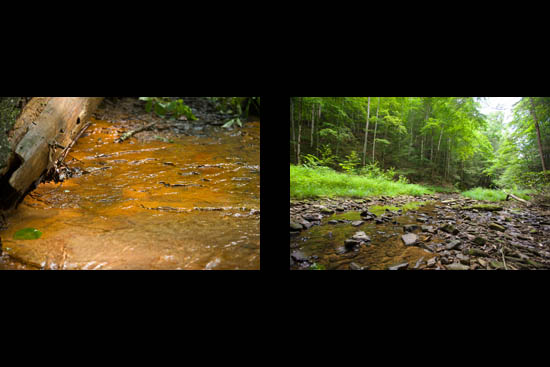Salamander populations affected by valley fill
Salamander populations affected by valley fill

The salamander population in the headwaters of Appalachia is both large and rich in a variety of species. At least in the undisturbed headwaters, that is. UK Department of Forestry scientist Steven Price has determined through a study of 23 Eastern Kentucky headwater streams that mountaintop removal mining and subsequent valley fill takes a toll on the amphibians’ numbers.
This style of mining, where the tops of mountains are removed to access shallow coal seams, is common throughout the central Appalachian Mountains. The practice results in a great deal of overburden material—rocks and soil—which is often poured into adjacent valleys, covering all or portions of headwater streams found there. In addition, valley filling can change water chemistry through leaching and surface runoff.
Salamanders are the main vertebrates in these low-order streams—shallow streams that occasionally can go dry—where their populations are vital to a balanced ecosystem.
“They are probably the most important vertebrates in these lower streams, in terms of abundance,” said Price, assistant professor of stream and riparian ecology in the College of Agriculture, Food and Environment. “Removing them from a system may have some impacts to the food web. They seem to be fairly sensitive to changes in land use, and often it’s hard for their populations to recover.”
Salamanders are not usually found in higher order, permanent streams, because they don’t coexist well with fish. In headwaters, however, they are important predators of invertebrates and, in turn, reptiles, birds and mammals prey on salamanders.
While salamanders are sensitive to changes resulting from a variety of land use practices, until now little research has been done to evaluate their response to valley fill from mountaintop removal surface mining. Price’s team of researchers conducted repeat counts of salamanders at headwater streams located in the interior section of the Cumberland Plateau in Breathitt and Knott counties—11 streams partially buried by mining overburden materials on the reclaimed Laurel Fork surface mine and 12 undisturbed streams on UK’s Robinson Forest.
“What we found was the abundances were quite different between the site types, with the reference sites on Robinson Forest having many more salamanders than those on the mountaintop removal sites,” Price said. “We were ultra conservative in our statistical procedures, and yet we still found differences.”
Price’s team concluded that the drop in salamander populations in the valley fill sites likely is due to a variety of stressors in both streams and the surrounding areas. Often there is minimal forest cover after mining has depleted the soil. On the 11 mountaintop removal sites the team studied, most of the land was in grasses and shrubs, with only 25 percent forest cover. The Surface Mining Control and Reclamation Act of 1977 requires revegetation of mined land, but this usually involves seeding the recontoured land with grasses. The drier, warmer and windier conditions that arise without adequate forest cover are detrimental to salamanders.
Soil compaction at these sites often leads to storm runoff and greater flooding potential, both of which reduce survival of larval salamanders. Changes in water chemistry, as well, have been associated in other studies with a decrease in microinvertebrates—important prey species for salamanders, a fact that also could affect salamander populations.
From the results of his study, for which he was recently awarded the Senior Research Award by the Association of Southeastern Biologists, Price concluded that the current regulatory framework used to offset the impacts of this kind of surface mining might need to be revisited.
“In addition, alternative reclamation techniques could aid in the recovery of aquatic ecosystems and semiaquatic organisms on reclaimed mined land,” he said.
Price’s paper, co-authored by Breneé Muncy, Simon Bonner, Andrea Drayer and Christopher Barton, recently was published in the Journal of Applied Ecology.
Forestry & Natural Resources Research


